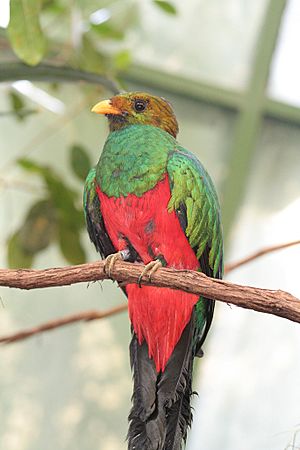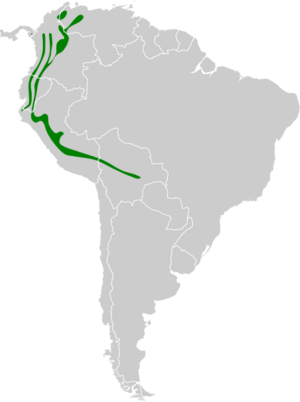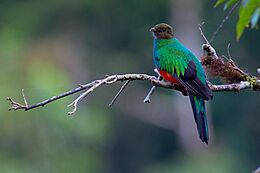Golden-headed quetzal facts for kids
Quick facts for kids Golden-headed quetzal |
|
|---|---|
 |
|
| Male | |
| Conservation status | |
| Scientific classification | |
| Genus: |
Pharomachrus
|
| Species: |
auriceps
|
 |
|
The golden-headed quetzal (Pharomachrus auriceps) is a beautiful bird. It has bright, shiny colours. You can find it in wet forests from eastern Panama to northern Bolivia.
This quetzal is famous for its shimmering green feathers. It also has a special golden head. Female quetzals are not as bright. They have more brown colours than the males. Golden-headed quetzals mostly eat fruit. Sometimes they also eat insects. These birds usually live alone and are quiet. But during breeding season, a male and female will pair up. They make a nest inside an old tree. Both parents help take care of the eggs and feed the baby birds. This lasts for about 25 to 30 days. The golden-headed quetzal is quite common. It is not considered an endangered species.
Contents
About the Golden-headed Quetzal
The golden-headed quetzal was first described in 1875. This was done by John Gould, a famous bird expert. It is one of five birds in the Pharomachrus group. All these birds are called quetzals. They belong to the Trogonidae family. This family includes birds found in tropical rainforests around the world.
The name "quetzal" comes from an old language called Nahuatl. This was the language of the Aztec people. The word quetzalli means "long green feather." People often think "quetzal" only means the famous resplendent quetzal. But it actually refers to all birds in the Pharomachrus and Euptilotis groups.
The name Pharomachrus comes from Ancient Greek words. Pharos means "mantle" or "cloak." Makros means "long." This name refers to the very long tail feathers of some quetzals. The species name, auriceps, comes from Latin. Aurum means "gold" and ceps means "headed." This describes the golden head of this bird.
There are two types, or subspecies, of the golden-headed quetzal. They are P. a. auriceps and P. a. hargitti.
What Does a Golden-headed Quetzal Look Like?
The golden-headed quetzal weighs about 154 to 182 grams. Its wings can spread 30 to 36 centimeters wide. The bird itself is 33 to 36 centimeters long. Its tail feathers can add another 8 to 10 centimeters.
Like other quetzals, it has shiny golden-green wings and chest. These colours can look blue depending on the light. Female quetzals have a duller, brownish chest. Their heads are also a duller golden-brown. Male quetzals have a bright gold-bronze head. This is where the bird gets its name.
Their beaks are short and wide. Males have yellow beaks, while females have brownish-grey ones. The feathers on their upper tails are darker green. They extend past the end of the tail. This is more noticeable in males. Both male and female quetzals have black feathers under their tails. Sometimes females have greyish-black tips. The feathers on their lower chest are a bright red.
Like other trogons, their feet are special. Two toes point backward, and two toes point forward. Their legs and feet are olive green or brownish. Young golden-headed quetzals are brownish-black. They have a few shiny green feathers on their neck and chest. They do not have the long tail feathers of adult birds.
The P. a. hargitti subspecies has a longer tail. It is also a bit more golden in colour.
Where Do Golden-headed Quetzals Live?
Golden-headed quetzals live in parts of Central America and South America. The P. a. auriceps type is found in eastern Panama. It also lives in the Andes mountains. This area stretches from southern Colombia to eastern Peru and northern Bolivia. The P. a. hargitti type is only found in the Andes of Venezuela.
They usually live in humid, wet forests on mountainsides. These are called montane and foothill forests. Sometimes they are seen at the edge of forests or in clearings. They also live in cloud forests. These birds live at heights from 1,200 meters to 3,100 meters above sea level.
Quetzal Behaviour
Vocalizations
The golden-headed quetzal is a quiet bird. It often sits still for a long time. When it does make a sound, its call is easy to recognize. It sounds like sad, hawk-like whistles. It repeats these sounds 6 to 8 times. It also makes a sound like a horse whinnying. Another call is a deep, sad "ka-kaaaur."
These birds seem to react strongly to recordings of their own calls. This might mean their calls are used to mark their territory.
Diet
The golden-headed quetzal mainly eats fruit. But it also eats insects sometimes. Studies have shown that their stomachs mostly contain fruit. Only a small part contains insects. Because they eat so much fruit, quetzals are very important. They help spread the seeds of the fruits they eat. This helps new plants grow.
Some people thought quetzals also ate small animals like frogs and lizards. However, recent observations suggest this might not be true. One study watched these birds for 22 days. They only saw them eat insects, not other animals. This study also found that baby quetzals are fed fruit much earlier than once thought.
Reproduction and Life Cycle
Golden-headed quetzals usually live alone. But during breeding season, they find a partner. The male bird sings to attract a female. He also sets up a territory.
Once a pair forms, they find a good spot for their nest. They both work to dig it out. All trogons, including quetzals, nest in holes. Golden-headed quetzals dig into rotting tree trunks with their beaks. Or they use holes already there. Quetzals make shallow, open nests. You can often see part of the bird, like its head or tail, sticking out.
Finding a good nest site is hard. The dead tree must be soft enough to dig. But it also needs to be strong enough to hold the nest. So, quetzals check many trees before choosing one.
Not much is known about how quetzals mate. They seem to be very private. Golden-headed quetzals breed once a year. This happens between February and June. The female lays 1 or 2 pale blue eggs. She sits on them most of the time. This incubation period lasts 18 to 19 days. The male also takes one long turn each day.
Baby quetzals stay in the nest for 25 to 30 days. They are born blind and without feathers. Like all trogons, they develop their first feathers about 3 days before leaving the nest. These young birds look mostly brown and black. But they have green feathers on their neck, upper back, and throat.
Both parents share the job of taking care of the young. For the first 8 to 14 days, adults are in the nest most of the day. After that, they spend less time brooding. The parents take turns feeding the baby. The parent not brooding brings food. Then they switch places. When they switch, the incoming parent lands above the nest. It makes a whinnying call. This tells the other parent to leave the nest.
When the babies are very young, parents go into the nest to feed them. As the babies grow, parents just lean in to feed them. Finally, the baby bird can sit at the edge of the nest. The parents feed it from there. The food they bring is usually insects, but also fruit. On the day the baby bird leaves the nest, it flies away. It stays near the nest for a while before leaving the area. Unlike some other birds, golden-headed quetzals keep their nests clean. They either remove or swallow all droppings.
Status and Conservation
The golden-headed quetzal is quite common where it lives. It is considered a species of least concern. This means it is not currently at risk of disappearing.



